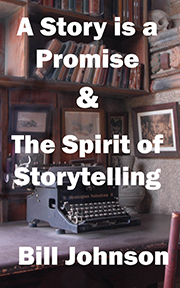|
|
Intuition and the Subconscious
by Bill JohnsonAn issue that arises in teaching the craft of storytelling is the place of teaching techniques, like outlining a novel before writing it, creating character sketches, or talking about a story idea with others, versus writing intuitively, starting with an idea or character or situation and just start writing and seeing what happens next. In an article by Kate Douglas (New Scientist, 1 December 2007, p 45-46), she writes about how the conscious and subconscious work together, referring to the work of Nathaniel Daw and Yael Niv.
In their research, Daw and Niv explored the idea that instead of having a strictly defined conscious and subconscious, that the conscious mind has a kind of auto-pilot 'to perform routine and instinctive behaviors.' When information is scarce, however-in unfamiliar situations or the very early stages of learning [think new story here]-another system, the episodic controller, takes charge. Instead of making complex calculations, it simply recommends adopting behaviors that have proved successful in similar situations in the past. Both rely heavily on conscious reasoning, and require you to focus on the problem at hand.
'By asking subjects to explain their reasoning as they go, he has found that verbalizing what they are doing has no effect on people's ability to solve analytical, mathematical or logic problems but actually hinders performance on insight problems...those for which the solution seems to pop out of the blue in an aha! moment...that our subconscious thinking is the source of our inspiration-it is central to creativity.'
For some writers, thinking too much about a story blocks their subconscious from creating an intuitive flow. But, to avoid over thinking, writers need to have internalized an understanding of storytelling. Whether they got that from studying good novels, movies, and plays, or studying the craft of storytelling, or some other method, will probably be idiosyncratic to each writer.
If as a writer all your brain power goes into deciding whether someone is walking, sidling, gliding or moon-walking across a room, you're blocking your subconscious from helping generate ideas.
Douglas's article continues, `A classic study into the neural basis of creativity suggests that it depends on an ability to shift gear between subconscious and conscious processing. Three decades ago, Colin Martindale of the University of Maine in Orono charted what is happening in the creative mind using EEG.... During the initial "inspiration" stage, their brains were remarkably quiet. Any activity was dominated by alpha waves, which indicates very low cortical arousal as though the conscious mind was quiescent while the subconscious worked behind the scenes. Intriguingly, you find a similar pattern during dream sleep and relaxation, two mental states associated with high creativity. This `inspiration" stage was followed by a second stage, "elaboration", characterized by far more activity, especially in the cortex, and probably associated with the conscious analysis and evaluation of ideas.
People with the greatest difference in brain activity between these two states were the most creative. More recently, Jordan Peterson at the University of Toronto, Canada, has argued in highly creative people subconscious information is more likely to spill into consciousness, giving them richer mental resources from which to make creative connections (New Scientist, 29 October 2005, p 39).'
The underlying point I see here is that someone who has internalized the craft of telling a story might need to quiet the analytical, conscious brain so they can write intuitively; while another writer might need to think through the elements of a story and have inspiration happening in the background.
In the end, writers have to figure out what style of writing works best for them. Writing can happen on a continuum from complete planning to only intuitive writing.
I've found that successful writers figure out what works best for them, while struggling writers often remain stuck in a loop of unrecognized personal storytelling. I suspect others spend so much time thinking through story ideas, they block their intuitive creativity from supplying them with ideas. Others want to remain so immersed in the creative flow, they don't want to step out of it to learn how to analyze their writing.
There is no easy answer or one size fits all answer to how to understand storytelling. Recognizing how the subconscious mind can aid in storytelling can help some writers relax and let their subconscious 'speak' to them.
****************************
I further develop some of these ideas in my writing workbook.

To learn about the craft of storytelling, check out my writing workbook, A Story is a Promise & The Spirit of Storytelling, available on
Amazon's Kindle for $2.99
and Barnes and Noble's Nook.
The book includes meditation techniques that can be used to speak to story characters and to an author's deeper self.
Also available on Barnes and Noble's Nook, Kobo, and Smashwords.